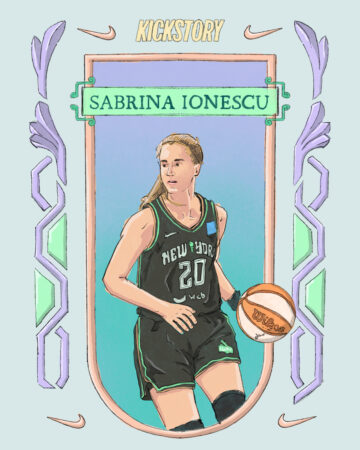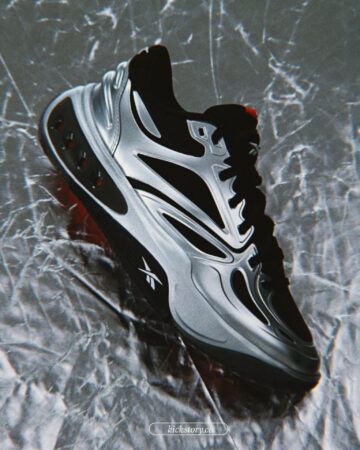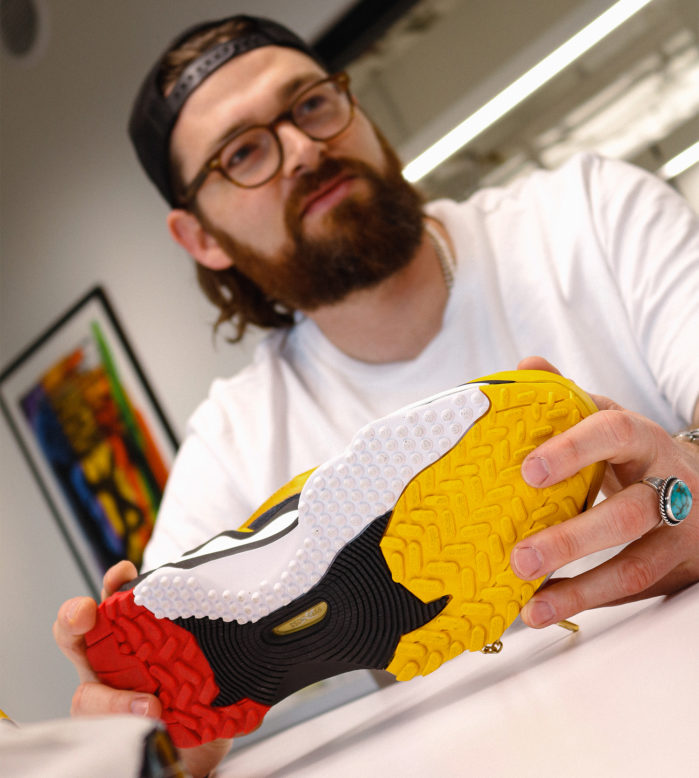
Our last interview in Boston was really something special and a once in a lifetime kind of moment for us. In an amazing interview inside the Reebok archive, we sat down to talk with Michael Hesterberg, Design Director of Innovation at Reebok.
Michael has been at Reebok since 2016, where he worked on some really cool stuff over the years from running, to lifestyle, to basketball and even spent some time on the Advanced Concepts team. But the story he chose to tell was about his work with Kerby on the Pyer Moss x Reebok Experiment G. Not only did he invite us to the archives but he also pulled out some original samples and prototypes of some sneakers that were the essence of what he liked about the brand. He pointed out some of the sneakers and design elements he used as reference, that are clearly present in the Experiment G.

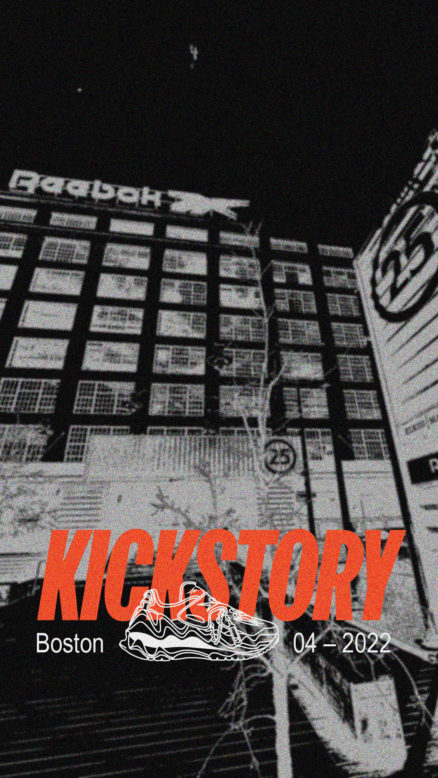
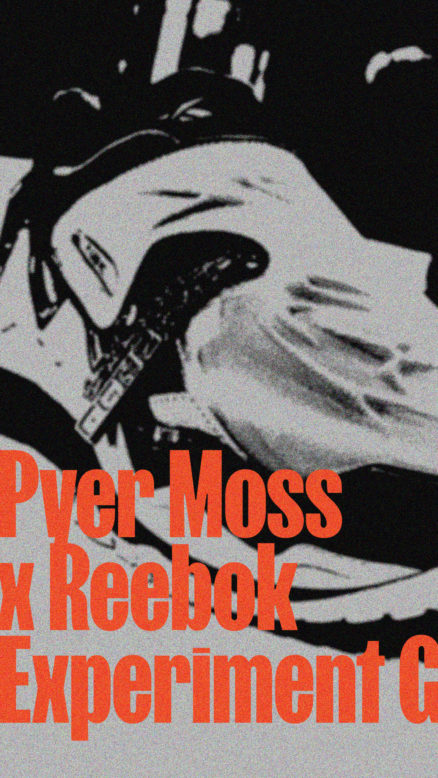
“I’m Michael Hesterberg, I’m the Design Director of Innovation at Reebok, and I’m excited to show you my work and a little bit about our brand.”
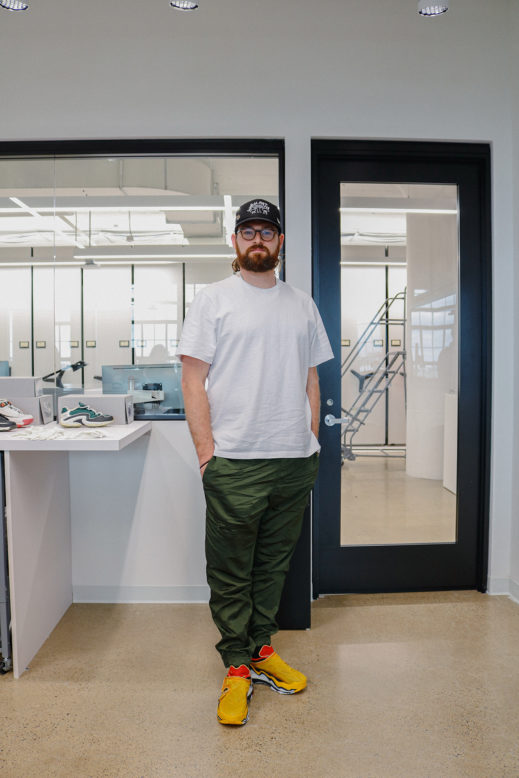
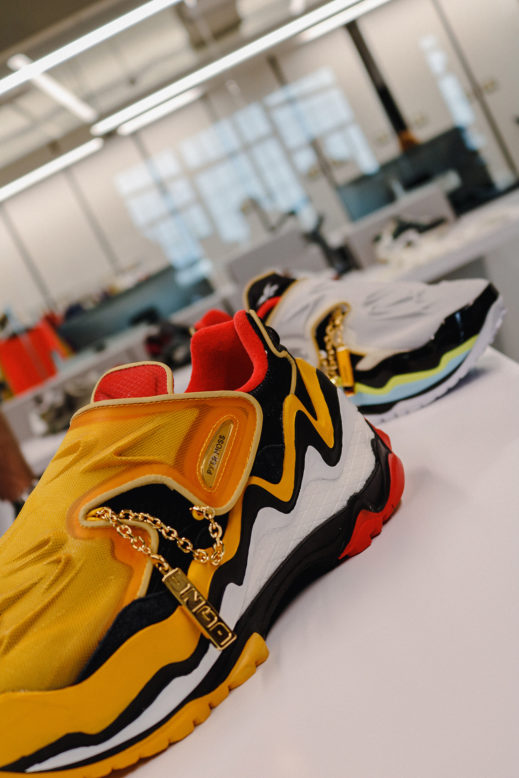
So first, let's talk about your interest in design and being in the creative field. What made you want to create sneakers?
michael I’ve always been interested in objects and passionate about creating things. My grandfather would always buy me a “back to school” pair of shoes, and there would be ones that I couldn’t afford, or my parents wouldn’t buy me. So he would spend extra money to give me cool shoes (laughs). That’s kind of how I got interested in sneakers.
I sold shoes in high school at Champs Sports, and I really loved learning about the different performance properties, selling them to people and telling them about shoes. One day, my boss was like: “I wonder who designed these.” And I’d never thought that was a thing that happened, that there was someone who made shoes. So from that moment on, I was like “I’m gonna do that.” My dad was a painter, my mom was a teacher, and I wanted to do something where I could work, be creative, have steady income and not have to live as an artist in North Carolina, which is not really a bustling metropolis, it has agricultural roots. So I started to think “where could I go? What can I do with design and art?” At the time, that area wasn’t really known. I think I learned about industrial design from a pamphlet or something.
I wanted to get into sneakers and figure out how sneakers were made, and the internet did not cater that like it does now. Instagram to me feels like a resume, you can see everything, you can learn anything from YouTube, which is really cool. But when I came up, there was no “map” on how to get where you wanted to go, you had to figure it out. There’s one book I found, “Sole Provider”. I can’t remember who the author was, but it had some Nike sketches in it and I was like “oh, that’s what it should look like”.
I got to NC State, which is a major industrial design school in North Carolina. It has Bauhaus roots, but it’s not very well known. I studied industrial design there and even then, sneakers were always something that existed outside of traditional industrial design, and at the same time, outside of fashion as well. You could go to fashion school, or you could go to industrial design school and learn about footwear, but neither of those disciplines encompassed all you need to know on how to be a sneaker designer. It’s the sculpting, the 3D forms and manufacturing. It’s different how people interface with these things, sneakers have an emotional connection.
“I sold shoes in high school at Champs Sports, and I really loved learning about the different performance properties, selling them to people and telling them about shoes. One day, my boss was like: “I wonder who designed these.” And I’d never thought that was a thing that happened, that there was someone who made shoes. So from that moment on, I was like “I’m gonna do that.””
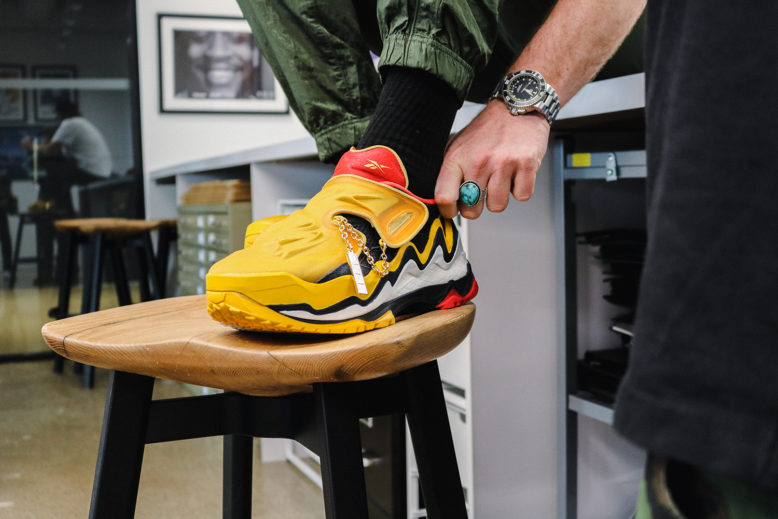
And how did you learn about shoes and shoe making? Did you have to take any special courses?
michael I just studied. I mean, that’s why my sneaker collection is so interesting, because there’s not a ton of hype product in there. Most of it are things I wanted to experience – what does it feel to wear this shoe? What does this technology feel like, how does this construction feel? These were things I wanted to learn. So I picked it up, by talking to people, by cutting shoes apart, by buying interesting samples and wearing them. I was always interested in the weirdest stuff I could find.
“Most of it are things I wanted to experience – what does it feel to wear this shoe? What does this technology feel like, how does this construction feel? These were things I wanted to learn. So I picked it up, by talking to people, by cutting shoes apart, by buying interesting samples and wearing them. I was always interested in the weirdest stuff I could find.”

How did your career in sneakers begin?
michael I wanted to do shoes so bad. So all my school projects were like, if I could turn it into a shoe, I would turn it into a shoe, and I think people got sick of it (laughs). But I wasn’t sure I could make it as a sneaker designer because there weren’t any sneakers brands in North Carolina and also, trying to find an internship was not easy, coming from that school. But I got pretty lucky because right after I graduated, the man that hired me had studied at NC State and had the same professor I did. He was an adidas designer, and he was in town for a golf event at Pinehurst. He decided to stop by the school because he needed an intern so he asked my professor who he would recommend, and my professor said “the guy that always draws shoes.”
I started at adidas golf as an intern. They were still doing sketches by hand and airbrushing them. I had a Cintiq tablet (drawing tablet) that I bought for my own work, and I brought that to the company and kind of modernized the way they did presentation drawings. I don’t know how I got the job, I mean, I just drew a lot (laughs).
Do you remember the first project you did over there?
michael It was a postgame slide. I just picked up whatever projects nobody wanted to do, or nobody had time to do. I also made a couple of takedowns; I did a golf version of the Stan Smith, with spikes on it, it wasn’t hard or challenging, I just said – ok I can do that, easy.
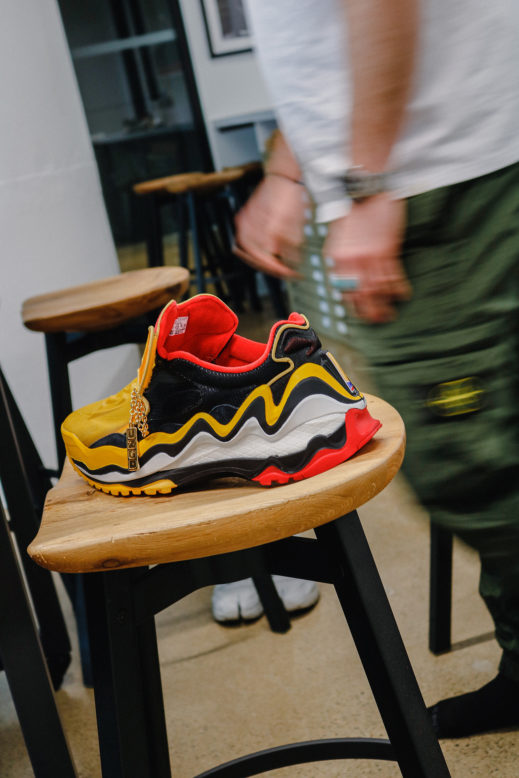
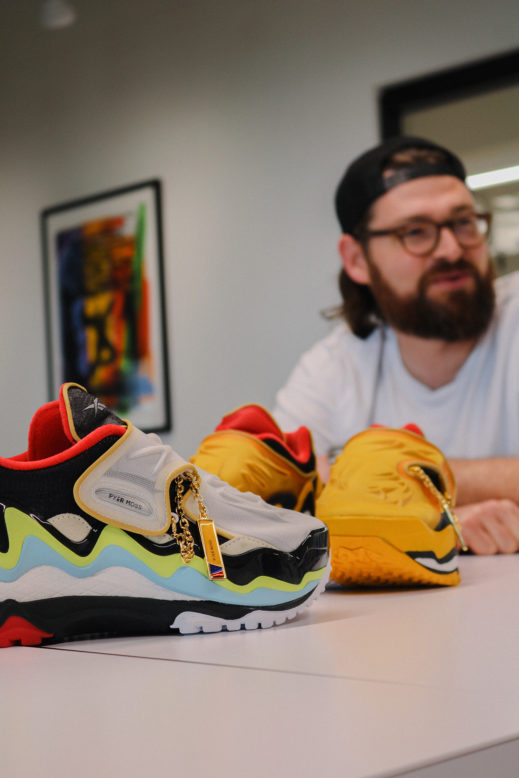
And how did you land at Reebok?
michael I’ve worked at adidas for 10 years. And basically, everything went full circle, I was just starting over all the stuff I had already done. We did the adidas Tour 360, we brought adiZero, Boost golf, and some other stuff. Golf was the number two category for boost in 2015 – it was running and then golf. It was when they couldn’t make boost in the quantities they do today, so the same parts had to be allocated to different shoes. The first golf shoe to have boost was actually the response heel piece from a running shoe, and they didn’t need the mold anymore because they were already moving on to ultra boost. So we had to take that part and modify the rest of the shoe to fit in.
I got really interested in technology, and how to make athletes better and got into the weeds of making stuff. But at the same time, I wanted to try something new and I really am interested in sneakers and sneaker culture. I wanted to do something really expressive, not just performance stuff. And what I did for adidas was very much for a 55 year old golfer, not really me.
So in 2016, I got the opportunity to come to Reebok to work with performance running, and later on moved to lifestyle running – mostly Zig, and there’s a few other products in there that I worked on. Then I worked on basketball and advanced concepts – it’s top secret, all the cool stuff in the basement. And because I worked in both advanced concepts and in lifestyle fashion, I got the opportunity to work on the Experiment G. It was one of the coolest experiences, it’s a bit of all of the things that I am interested in. It’s very technical knowledge about making shoes, because the fashion timelines are so fast and aggressive, it puts limits on what you can make. But through all my experiences, I learned how to make a lot of things, and I got the opportunity to do this.
Reebok is a brand with a similar history to adidas, there’s not that many brands that have the heritage you can call back on. To work with a brand that makes cool shit for years and years, is exciting, it’s what keeps me here making stuff.
“To work with a brand that makes cool shit for years and years, is exciting, it’s what keeps me here making stuff.”
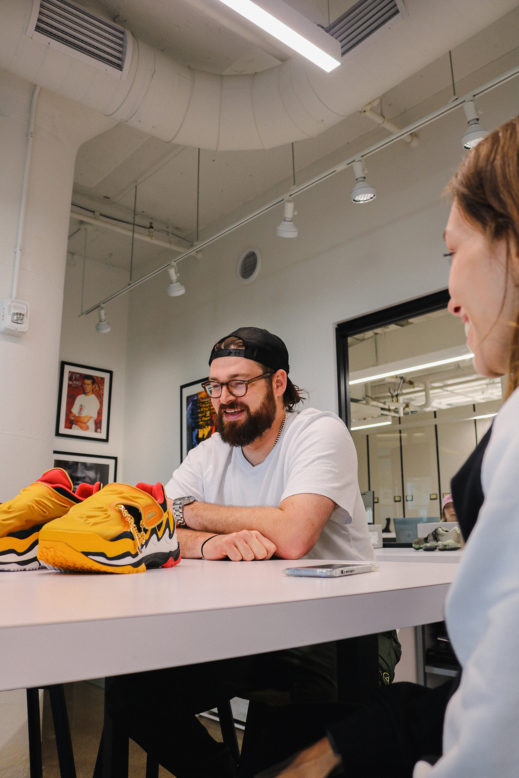
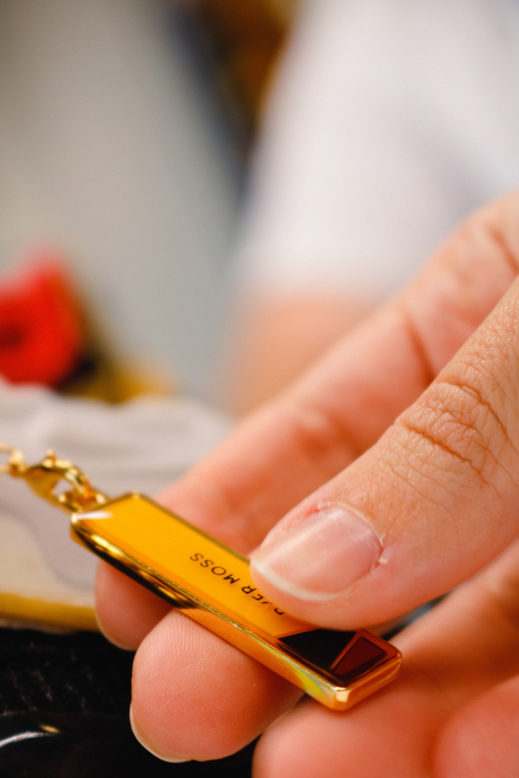
Did you see a difference between making a performance sneaker and a lifestyle one?
michael For most smaller sports companies, they’re kind of similar. I mean, for performance, your considerations are about the athlete and how to make their experience better – is it more comfortable? Is it lighter weight? Has it improved their ability to run longer? Does it protect them from injury? All these thoughts are not at all used for fashion. You might be able to make things like that for fashion, but the point of view is all about aesthetics in fashion. It’s proportion, materials, stance, construction attitude. It’s a very emotional place. A lot of that point of view comes from the designer, and in this case, it’s Kerby Jean-Raymond from Pyer Moss. It’s his aesthetic, it’s what he wants to say. And I get to be fortunate enough to be the pencil that creates the footwear part of that story.
“A lot of that point of view comes from the designer, and in this case, it’s Kerby Jean-Raymond from Pyer Moss. It’s his aesthetic, it’s what he wants to say. And I get to be fortunate enough to be the pencil that creates the footwear part of that story.”
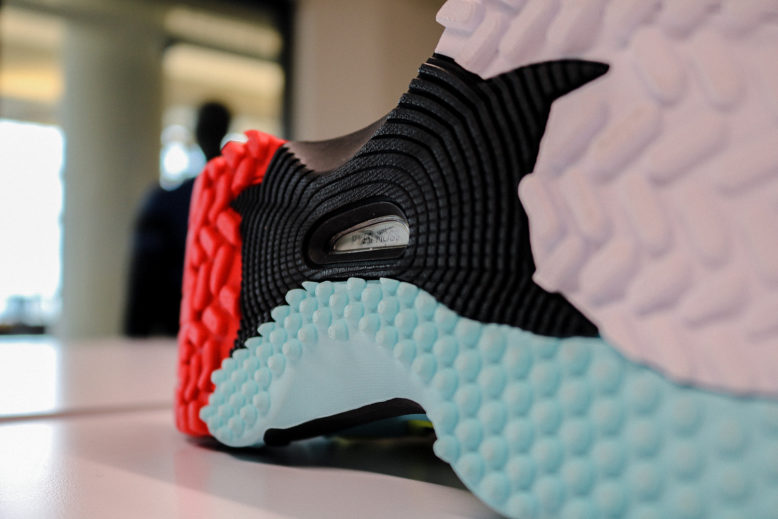
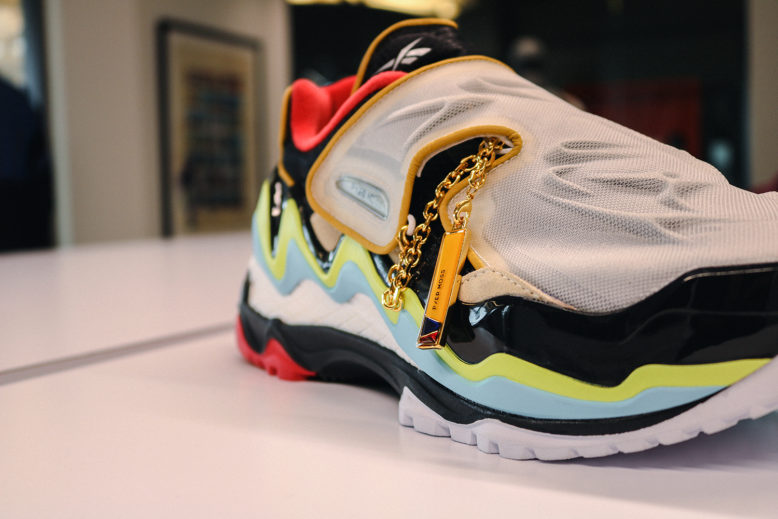
And why out of all the projects you worked on, did you choose to talk about the Reebok x Pyer Moss Experiment G for your Kickistory interview?
michael I think that’s the reason, it’s all the things that I am interested in. I’m often a maximalist, I just want to do everything all at once, and to have the opportunity to work with somebody who also sees things that way, who wants to make it deliberately different, is unique. A lot of times when you make sportswear, you have to appeal to a lot of people because you want to make the best thing for everyone. But in fashion, you are more interested in the storytelling and you also want to stand out, right? So you need to do things that are different from everyone else. So that’s pretty fun for me.
I like doing things like putting gold chains and holograms on something. The wrinkling cloth, the softness, there’s no reason to do that for sportswear or for any performance product, unless it makes it more flexible. There was no reason to make it wrinkly, but it looks beautiful, it feels like a draped cloth idea. So for me, it was a rare opportunity to try all these things that I’m excited about. Working in advanced concepts, you’re always trying to find the newest materials and manufacturing methods to create newness. All of these things behind us are created by people looking for new ideas, new experiences, new materials and manufacturing methods. I want to be able to continue that, to fill the archive for whoever becomes me 10, 15 or 20 years later. It’s a culmination of all my experiences and knowledge. Being able to fill someone else’s creative tanks is also the goal.
“Working in advanced concepts, you’re always trying to find the newest materials and manufacturing methods to create newness. All of these things behind us are created by people looking for new ideas, new experiences, new materials and manufacturing methods. I want to be able to continue that, to fill the archive for whoever becomes me 10, 15 or 20 years later. It’s a culmination of all my experiences and knowledge.”
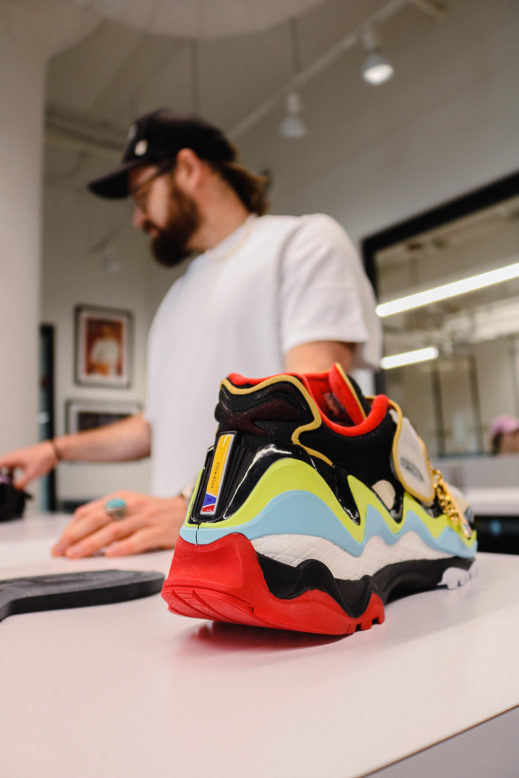
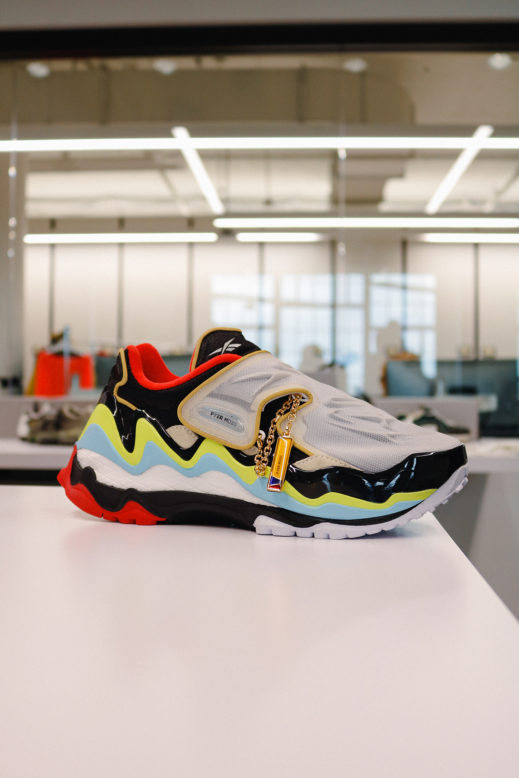
This sneaker is so unique. What is the story behind the Experiment G?
michael I didn’t fully know what his collection was going to look like, I could only see so far and it was still taking shape. We were creating objects that were going to take shape onto whatever the collection becomes, but at the same time I didn’t have visibility to all of that. But for this particular collection, we wanted height, we wanted it to be the taller shoe out of all of his other shoes. Also, he was exploring ideas around spirituality – which you also would never do at a sports company – but you can do that as a fashion designer.
I had just come from a trip to Barcelona where I went to La Sagrada Familia, which by the way, is the most beautiful place on earth, it’s just stunning! I’m not a religious person but it’s a spiritual place. And when I saw Kerby design notes, he was looking at jewelry, royalty, self-reflection and self-worth. I definitely pulled my experiences from La Sagrada.
When you look into the rafters of the church, there’s these glowing orbs and I don’t even know what they are, but I said – we can do that. The chains also are a reference to royalty. I mean this jewel in the sneaker is stained glass, it’s translucent and it looks like a jewel. Those are things that I added to embellish that story and to bring something that doesn’t come from me, into creating the footwear piece. And that’s also another challenge, it’s not overtly Reebok branded.


This cloth effect on the upper is amazing. What was the inspiration behind it and how did you get to this result?
michael Kerby had given the painting of a woman draped in cloth, and it felt very religious. But how do you create something that feels draped? I wanted it to feel frozen in time, but also soft, and I had to figure out how to make that. The first thing I did was take a cloth, drop it a bunch of times and take photos of that movement. Then, I sculpted it in clay, and we 3D scanned it.
This wasn’t the only way I made it. I also had taken those forms and put them into 3D software to recreate them, so that I could hand them to the factory and get them to this soft shape. I could spend hours drawing all these sections but it would never feel natural. So we tried to vacuform it, but didn’t really work. So I had to create a mold, a hard mold, so that the factory could lay a material over it and make it look soft and draped. But because this was supposed to be a very quick fashion shoe, how do you do that quickly without wasting time?
Because of COVID this sneaker almost didn’t happen, and that’s just another reason I wanted to talk about it. It was previewed at Paris Fashion Week. In his space, I did a 3D rendering so that you could visualize the shoe. So I started the shoe in 2019 and it was supposed to come out in 2020, but COVID really shut down the entire sneaker industry. We couldn’t make things, we couldn’t ship things, stuff got put on hold, and we basically had to start the whole shoe over again.
It started out on a different bottom – it was cool to make this bottom – initially I was going to use an existing bottom but because of the delay, we were able to make this unique bottom. Kerby hadn’t done like a trail inspired running product and hadn’t used any premium foams so far. So we looked at what our options were for midsoles, and we took this from running. We used the Floatride Energy Symmetros midsole, which is made from a pellet foam.
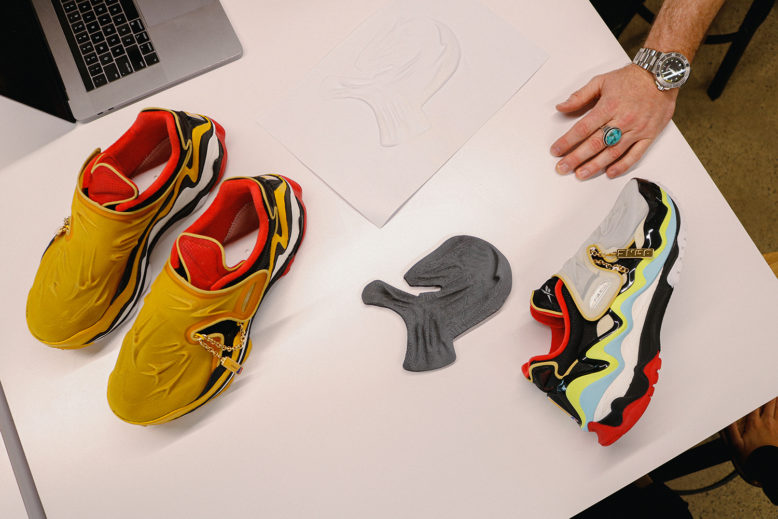
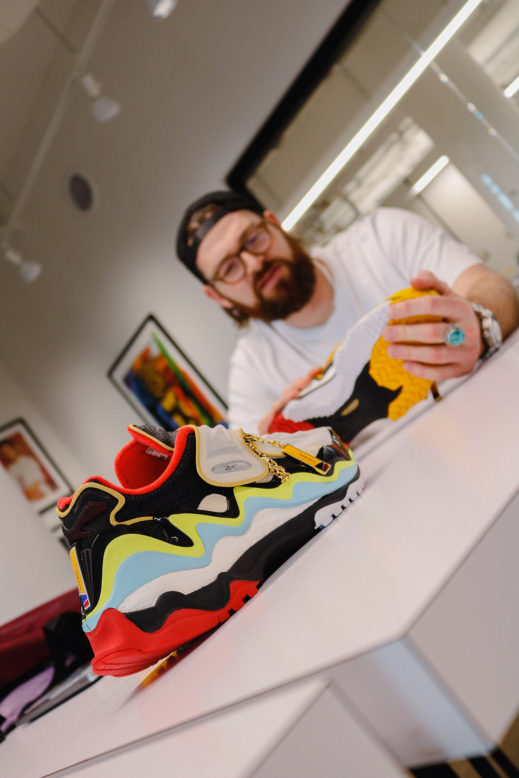
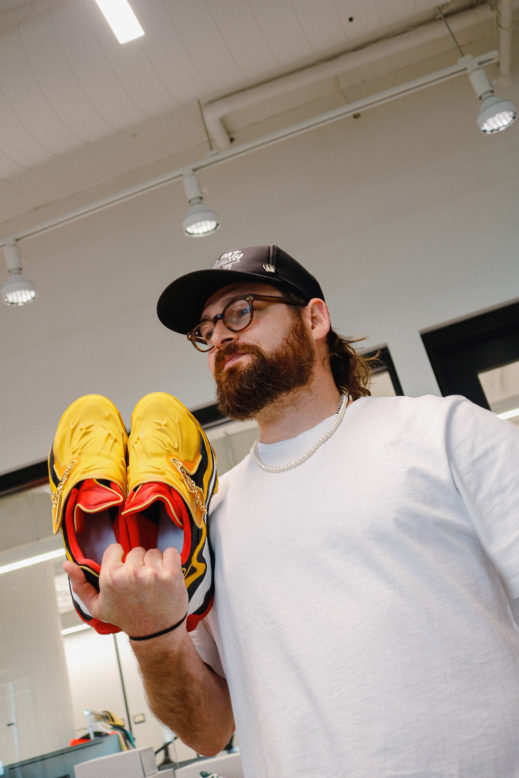
We can see that the sole has different patterns and texture. Where did it come from?
michael So, the heel and toe textures are a reference back to the running line, so that they have a little bit of connection. Besides, that’s one of the easter eggs that I snuck in. I do a bit of yoga, and I think that’s another spiritual and mindful practice, and when you put your feet together, the English saying is to “put your feet in prayer”. So I wanted the bottom to be two hands praying. I don’t know, maybe it’s too much, but it was fun, people can discover these details. That’s why it’s broken this way.
We also have this lenticular holographic logo on the outsole – this circular pattern is something from the design notes, it was like a radiant burst from a Frank Ocean logo or something like that. And then I have this turf soil texture on this area. The shapes may not feel congruent, but there’s a reason they all exist smashed together.
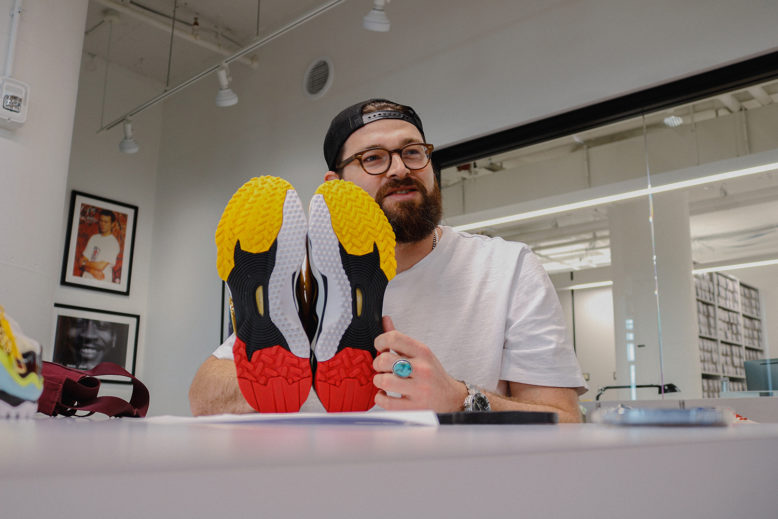
Before you went to college, you were already into sneakers. Do you think your relationship with sneakers changed since you began working with and designing them?
michael Yeah, definitely. I always liked unique things. And I think the sneaker industry is upside down right now, in that way. It has become a commodity, everybody wants to sell millions and millions of pairs, and those things have to appeal to a lot of people. But a lot of brands don’t want to do things that they don’t know if they’ll be successful. I think that’s one aspect.
The other aspect is that I think the culture has changed. DJ Clark Kent came here once and was talking about how he had to go to different places in New York just to get a pair of shoes in a different color. You couldn’t check online, you couldn’t use a bot. Even BAPE, you had to get stuff from Japan to be unique, and it was hard. And I think that was one of the things that globalization killed.
Also, I think that’s why people are interested in old things too, like thrifting, secondhand and reselling – they want to have something unique that nobody else will have. You have to search in places that other people aren’t looking.

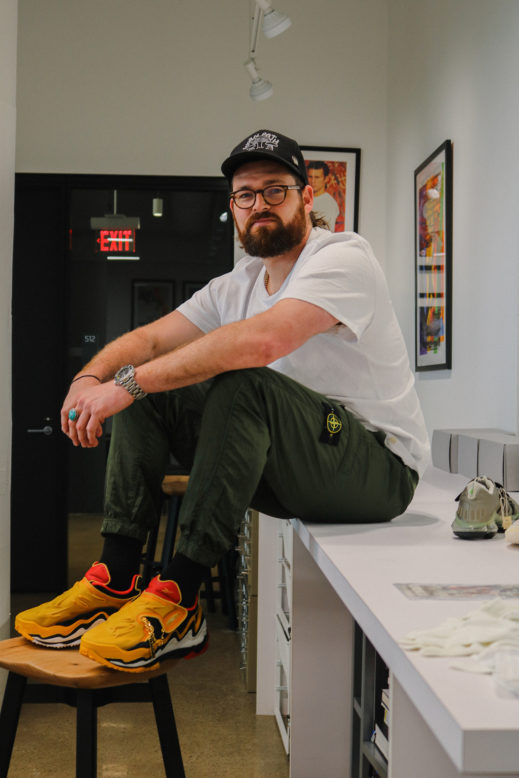
What are your favorite sneaker silhouettes looking from a designer point of view, and as a consumer?
michael I definitely have favorite silhouettes. I find myself sometimes wearing simpler stuff than what I want to design. If I’m doing sports, I want to wear something crazy, I want to wear something that’s the “feel good, play good” mentality. Having something new and flashy is what I want if I play basketball for sure.
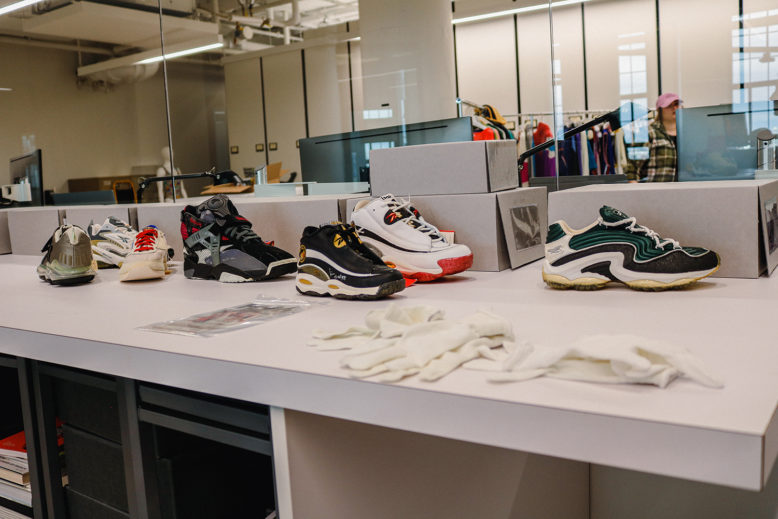
When you are creating a piece of footwear, what do you expect people to take from them, what do you expect them to feel? And what blows your mind even today?
michael My dream is that they are as inspired by it as I was, when I was getting excited about shoes. It’s like seeing something and being like “holy shit, it blew my mind. How did they make that?” I mean at first it was an emotional response but at some point, it was “how did they accomplish this?”
As my age and knowledge increase, I become more familiar with how shoes are made. But I think YEEZY is doing things that I haven’t seen before. That’s one of the cool things about that team, because of the scale of that business and the consumer, that’s one of the spaces where people are really driven for newness. So there’s “I like it” or “I don’t like it”, but it’s definitely different.
And when we talk about retros, I mean, that’s an interesting conversation itself. There’s the person who wants the one to one OG thing, and then there’s the person that wants that emotional feeling, but also wants what we have in performance today. And how much does that change? Does that ruin the object? How much is one to one original OG, exactly as it was made in 1996 versus, can we make it better? It’s a really tricky subject.
Does it have to be exactly the same while it could be better? Do you think that designer from 1996 thinks it turned out exactly the way they wanted it to? The prototype is right over here. You know, was Scott Hewitt happy with the one that went to market? it’s a classic conversation for the “sneakernerds” (laughs).
“My dream is that they are as inspired by it as I was, when I was getting excited about shoes.“
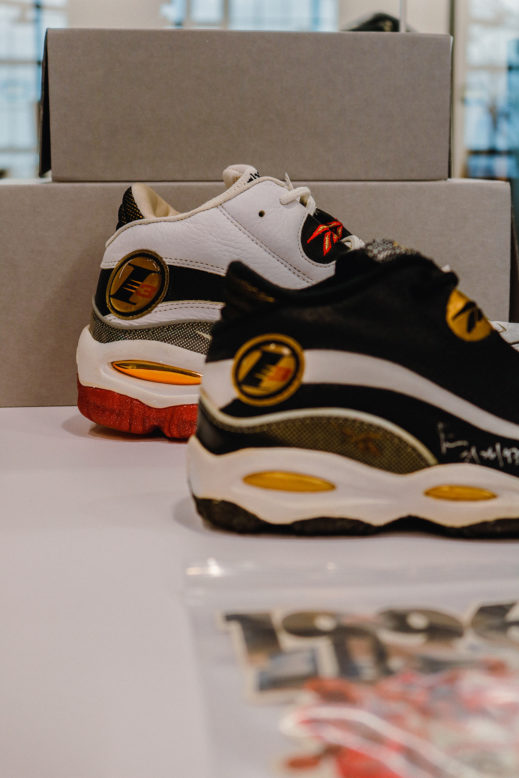
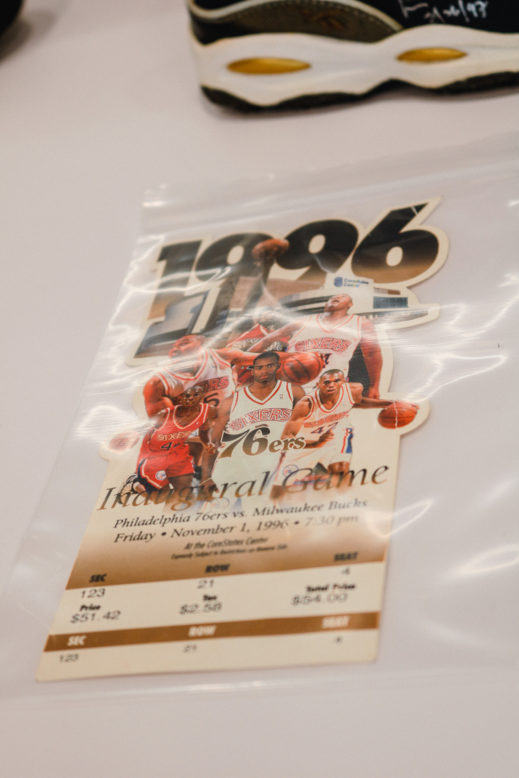
So you pulled out some sneakers from the Reebok archives, and we can see some design cues present on the Experiment G. What is it about them, design wise, that you like so much?
michael Though this isn’t heavily branded, it’s a collective memory of the brand that I pulled back from the archive. I’ve seen them, I’ve studied them, they’re things that inspire me to create new things. And then sometimes they show up in places unexpected or expected.
My feeling about sneaker design is that it exists in the period of time that the designers learned design. So everything pre-2000, is drawing by hand and cutting, it’s all the physical process of making something. And then, the period of the late 90s is AutoCAD, computer aided design, it was all Ford Taurus. It had these bubble headlights and the whole thing was just round. It was like car manufacturers finally figured out how to make sheet metal that wasn’t a square, and they used computer aided design to do it. So everything from that period has ellipses on it, it was all very ellipse driven.
Into the 2000s, Industrial Designers became footwear designers, that was not a field that did footwear, as far as I know. A lot of the old school Reebok designers were local Massachusetts people – they might have been from Mass art, or interested in art – they weren’t hired professionally through a sneaker design school. Even the Mutiny, but definitely the Diamond Series stuff, you can tell a person in industrial design school did this. It has a “producty” feeling to it. I always think that an industrial designer wants everything to be an icon and they want their design to be a pictogram of the object, which I don’t really like.
“Though this isn’t heavily branded, it’s a collective memory of the brand that I pulled back from the archive. I’ve seen them, I’ve studied them, they’re things that inspire me to create new things.”
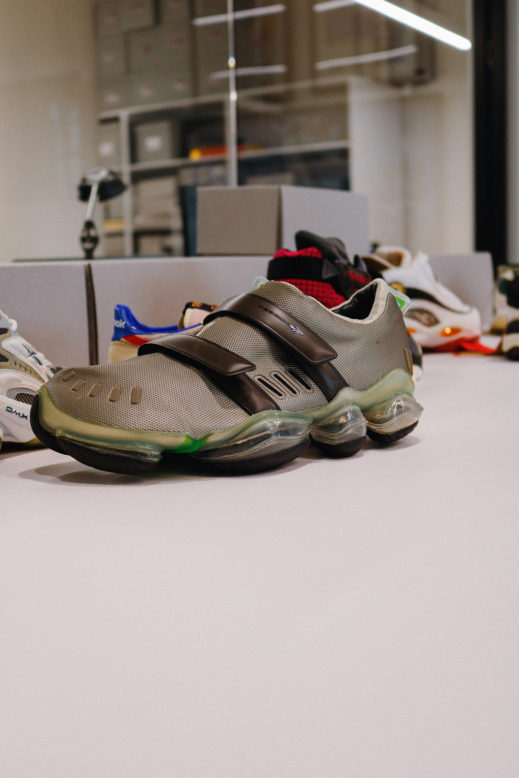

The Reebok Mutiny is one of my favorites. It probably comes from the Foamposite era, like Flightposite, this heavily molded era. I always loved this one because it has the molding, the transparency, the modularity and I always thought it was cool looking. It also has reflective piping so when you run at night you would get a flash of sparkle – it’s a safety thing for runners, running shoes typically have reflective hits on them. That’s one of the characteristics of the DMX stuff, it kind of reappears, re-emerges and evolves.
I feel everything in the 2000s was made by automotive designers. It doesn’t translate to 3D objects that are asymmetrical like footwear. Original footwear was created based on a pattern, like from traditional dress shoes like a Blucher or Derby. Even the Reebok Classic Leather, as much as the side panel is our logo, it looks like a men’s dress shoe, so you want to put the best and strongest piece of the leather on the toe and the less nice pieces on the quarter and heel. It’s a real throwback reference. So you take that knowledge, the knowledge of industrial design, manufacturing processes and now it’s all tumbling together the makerspace on Instagram, people really physically making one off pairs of shoes and also having the access to this knowledge as well. That’s kind of the aesthetic of right now – people making their own shoes and 3D printing them.
Pyer Moss x Reebok Experiment G
Owner: Michael Hesterberg
Year: 2022
Photos: Kickstory
